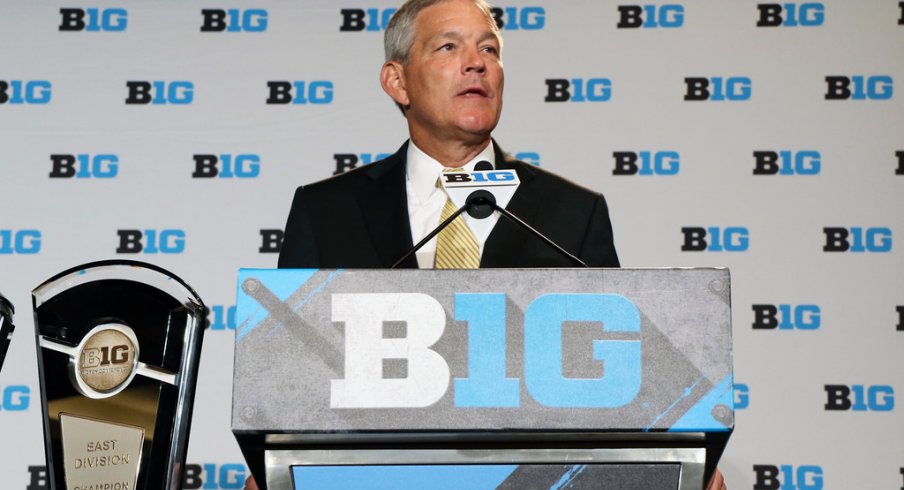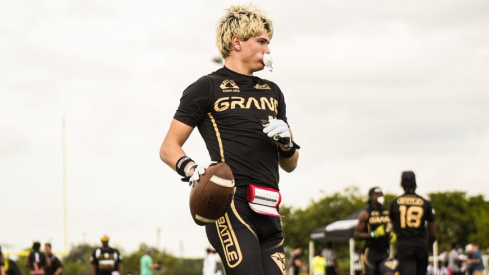It's all in the family in Iowa City with son Brian Ferentz now calling the shots on offense.
After turning in the 121st ranked offense for the 2016 season, Head Coach Kirk Ferentz decided it was time to make a change at the coordinator position. Ferentz decided to part ways with offensive coordinator Greg Davis and hired his son, Brian Ferentz.
Brian began his coaching tenure with the New England Patriots where he was an offensive assistant before eventually moving to the tight ends coach. It is no surprise that Brian started his coaching career with the Patriots given the close relationship between his dad, Kirk, and Bill Belichick.
Kirk Ferentz was the offensive line coach for the Cleveland Browns during Belichick's tenure as the head coach. Since then, both coaches have stayed in touch, often given people close to them coaching jobs.
In the upcoming 2017 season, Ohio State will play at Iowa on Nov. 4, a game that comes between matchups with Penn State and Michigan State. A game like this could often be a "letdown" game for the Buckeyes.
Coming off the Penn State game, which is likely to be a game that decides the Big Ten East, and before the always tough match-up with Michigan State, this game has all the makings of a very difficult game for Ohio State. With Iowa changing offensive coordinators, I decided to take a look at their run and passing games under Brian Ferentz in the recent spring game.
When watching Iowa's offense, the first thing you notice is how often they employ sets with tight ends and fullbacks, such as a pro-style offense. It is very different from what is seen in Columbus with a majority of their formations coming from under center as well.
run game
In the spring game, a majority of Iowa's runs were 'zone' runs, meaning that the offensive line is all stepping in the same direction to block.
The most common play seen during the spring game was a play known as outside zone. This play was popularized in the late 1990s by the Denver Broncos when offensive line coach Alex Gibbs mastered it. Since then it has become a staple of many offenses around the country.
On outside zone, the offensive line will use a 'numbering' system to block the defensive front. The center will identify the MIKE linebacker as who he is blocking since he is responsible for the first defender to the play side. This will be the player with the label '0' below. The offense will use this 'numbering' system on all zone run plays. On the play diagrammed below, the offense is in 21 personnel (2RB-1TE) with the fullback employing 'Boss' blocking scheme. 'Boss' stands for 'Back on Strong Safety'.
In the huddle, an example of this play-call would be 'Ride-38 Boss.' The most important part of this play is how the running back reads the cut. The running back is reading for if the defensive lineman is 'reached' or playing over the top of the blockers.
A defender is 'reached' if the offensive player has secured the block to where the offensive blocker has outside leverage. If the defender is playing over the top, that means the offensive blocker now has inside leverage and the back will run inside of him.
The running back will read the EMOL (end man on the line of scrimmage) as his first read. If the EMOL is being reached, then the running back will 'bounce' the run outside. If the EMOL is playing outside of the tight end's block, the back will now read the next defensive lineman inside.
If the tackle has this player reached, then the running back will 'bang' the run. 'Bang' refers to running the ball in between the two defenders he is reading. If the second defender is playing outside, or over the top, of the tackle's block, then the runner will 'bend' the ball back to the guard.
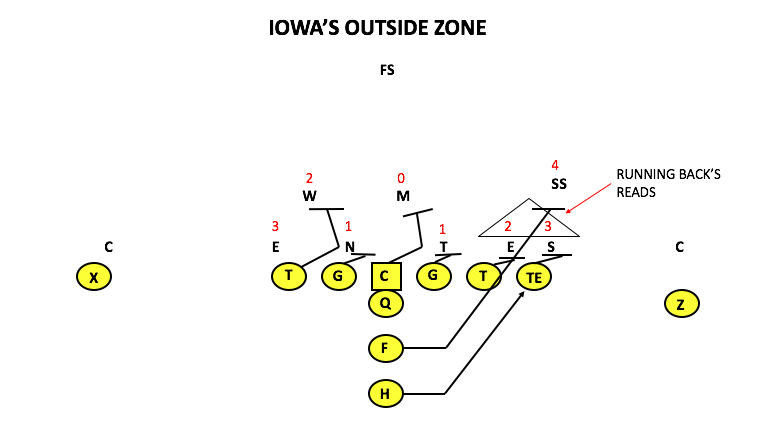
The beauty of this concept is once the defense starts to overplay, and over-align to the outside zone play, the offense will run the inside zone and 'iso' concepts. Iowa utilizes their fullbacks and tight ends heavily on their inside zone plays, often to block a backside linebacker that is unaccounted for.
Below is an example of a 'lead iso' run play that was often featured by Iowa in their spring game. The 'Iso' in the play-call is self-explanatory as the run features an isolation block by the fullback on a linebacker. The center will once again identify the MIKE linebacker, this time keying the fullback on who he is blocking instead of who the center is blocking.
The block on the fullback gives the running back a two-way go off the block. This is a great smash-mouth type of run, but it can be exposed when facing a linebacker that can blow up the fullback's block.
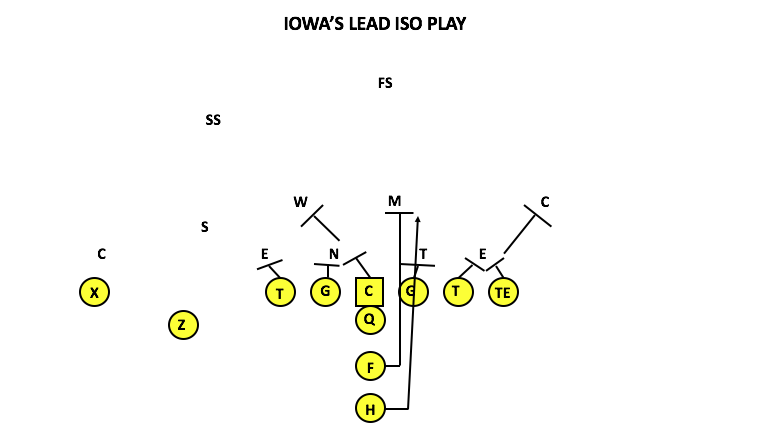
With the few plays featured above, you can see that Iowa utilizes a pro-style offense with zone runs. As with any run game, the play's success comes down to if your lineman can get a push up front.
passing game
Being a spring game in all, Iowa did not show a lot in terms of complexity with their passing game. They ran a few 'West Coast' concepts such as 'Stick', and 'Slant-Flat'. There was one concept though that appeared multiple times out of the shotgun that intrigued me. It is a great 'Quarters' coverage beater and gives the quarterback an easy read.
This is a play I expect to see against Ohio State in their November matchup, as the Buckeyes have shown that they will play a lot of 'Quarters' coverage, especially against 2x2 formations like the one below.
The 'Z' receiver will run a fade route as the corner will cover him in man-to-man coverage while the tight end runs a 10-12 out route. The back will run a 'shoot' route out of the backfield, meaning he is running a 3-5 yard out route and looking for the ball immediately.
In 'Quarters' coverage, the strong safety is playing the tight end in man coverage on all routes that are vertical past 5-8 yards such as the one below. The Sam linebacker is responsible for playing the 'flats', the short area from the line of scrimmage to about ten yards deep and to the sidelines, but he must 're-route' the tight end.
This leaves the quarterback with a very simple Hi-Lo read on the SAM, meaning if the SAM is slow to play the running back due to his re-route of the tight end, the ball will go to the back. If the Sam immediately takes the running back's underneath out route, then the ball will go to the tight end on the deeper out.
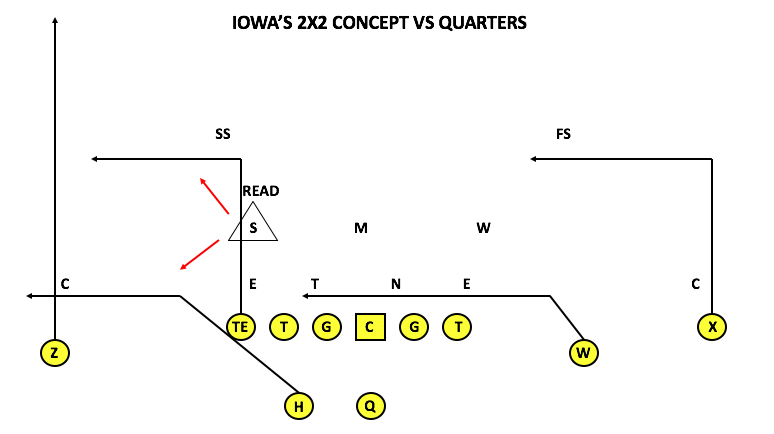
Below is the play against a cover-3 look. Instead of reading the SAM, the QB now reads the strong safety for the Hi-Lo read.
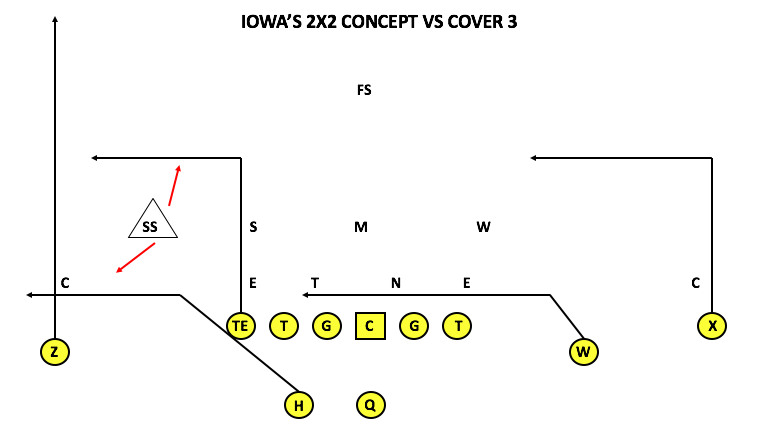
After studying Iowa's spring game, it was apparent that they face an uphill battle going into this season when throwing the ball, and if they want to contend for a Big Ten West title this fall, they will need to be better overall on offense. But with their ability to run the ball and play solid defense, they will always be in games and will pull the occasional upset like they did last November against Michigan.
Even though Ohio State will he heavily favored going into this November matchup, it could be a game in which the Buckeyes struggle.
